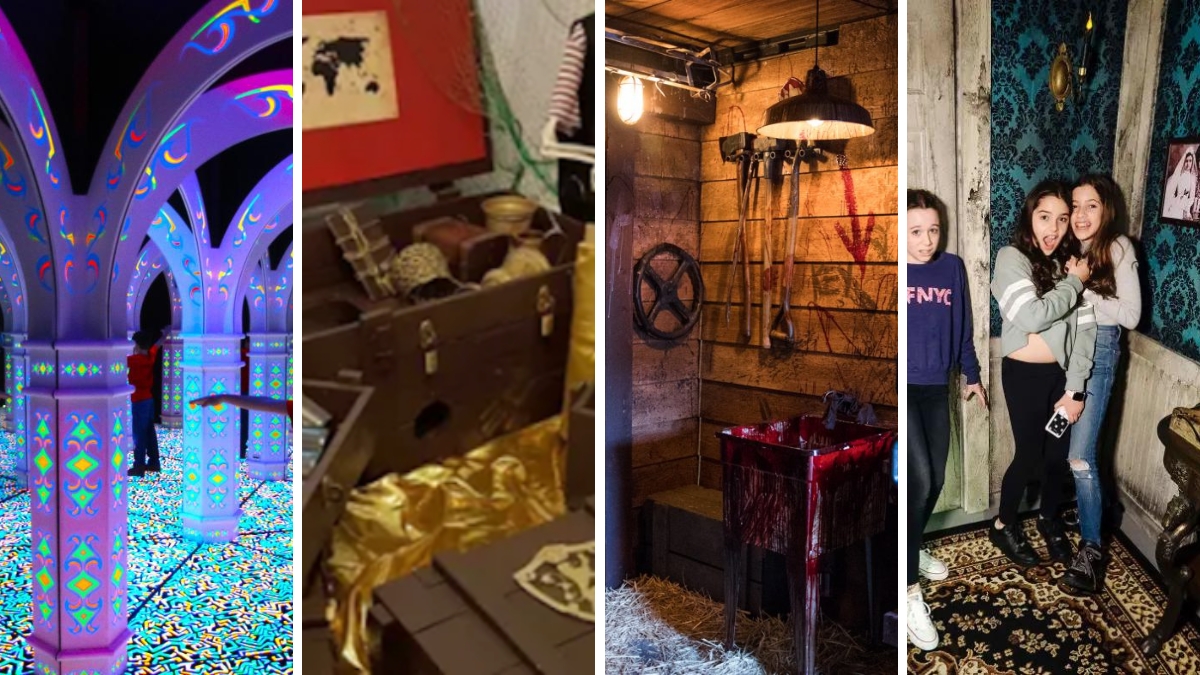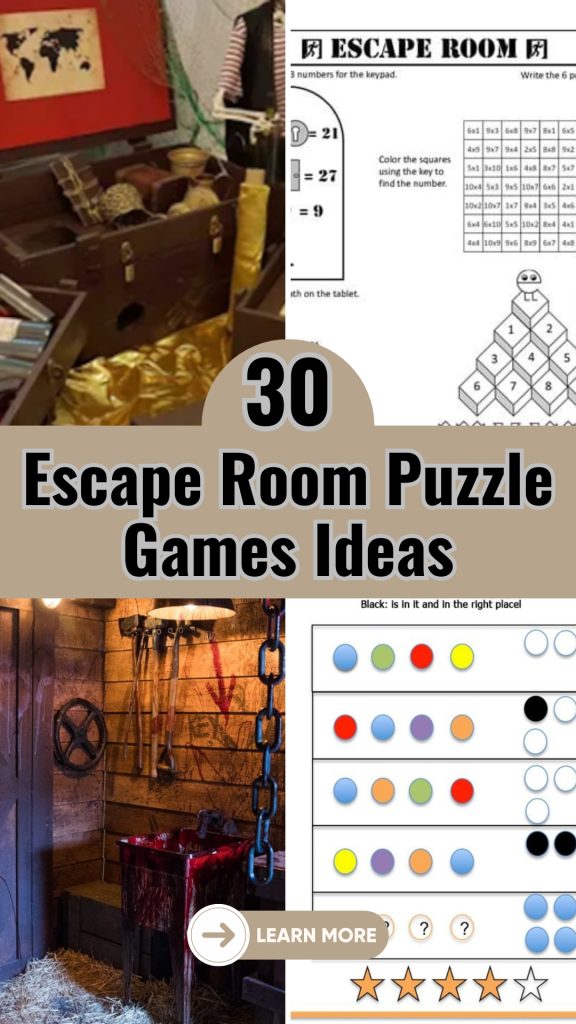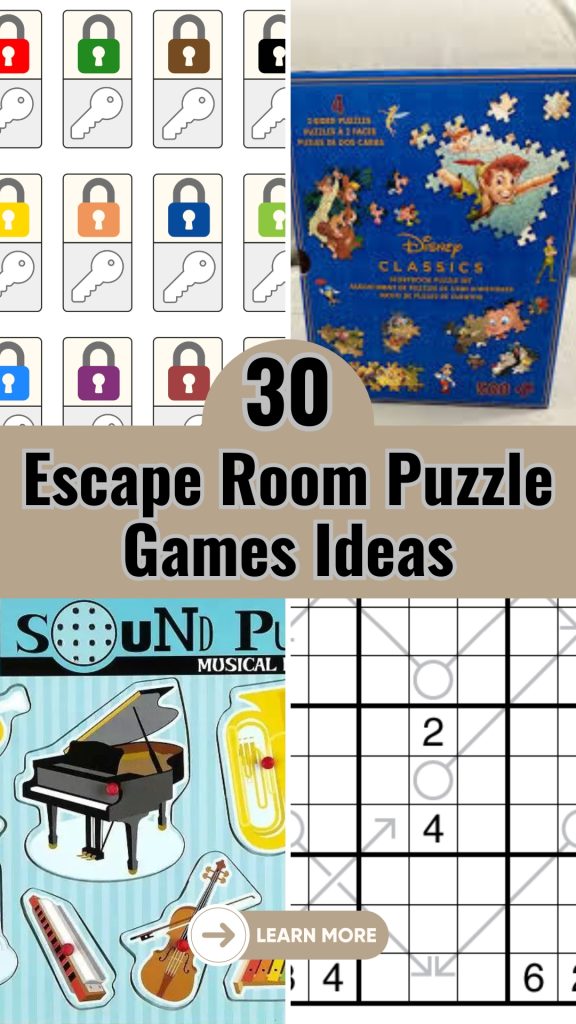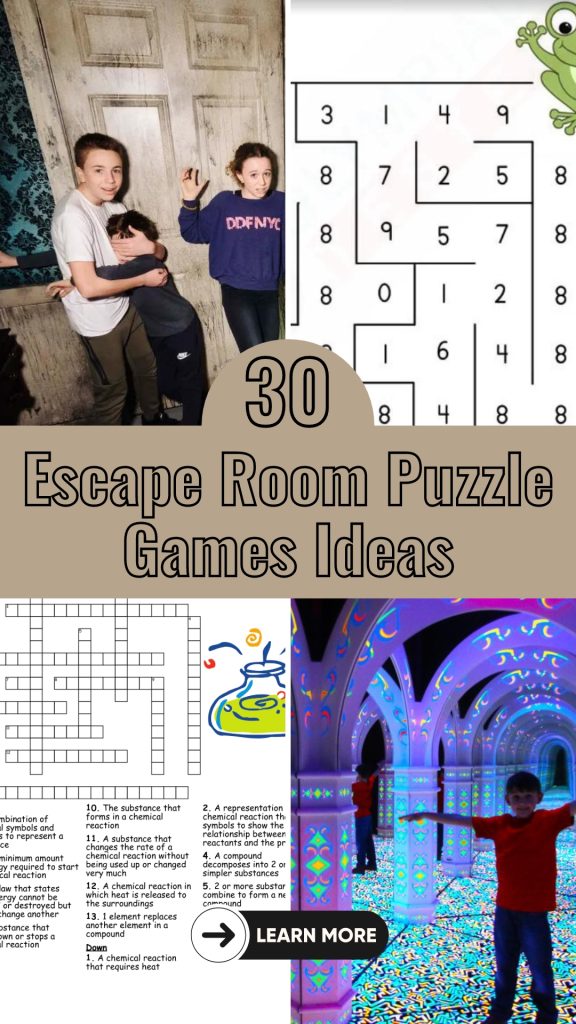30 Escape Room Ideas for Kids in 2025

Escape rooms are a fantastic way to entertain and challenge kids while keeping their brains active. They offer a mix of puzzles, clues, and fun themes that can turn any room into an adventure.
In this article, I’ll share 30 creative escape room ideas that are perfect for kids; that are easy to set up and sure to provide endless fun.
Let’s dive in!
Contents
- 1 30 Escape Room Puzzle Games Ideas
- 1.1 1. Mirror Message
- 1.2 2. Riddle Clues
- 1.3 3. Math Problems
- 1.4 4. Science Experiments
- 1.5 5. High Clue Hunt
- 1.6 6. Color-Coded Clues
- 1.7 7. Talking Animals
- 1.8 8. Jigsaw Puzzle
- 1.9 9. Treasure Box
- 1.10 10. Scratch-Off Clue
- 1.11 11. Lock and Key Pairs
- 1.12 12. Storybook Puzzle
- 1.13 13. Shape and Color Sorting
- 1.14 14. Mirror Image Challenge
- 1.15 15. Sound Puzzle
- 1.16 16. Egyptian-Themed Room
- 1.17 17. Sudoku Puzzle
- 1.18 18. Jigsaw Puzzle Lock
- 1.19 19. Message in a Bottle
- 1.20 20. Domino Chain Reaction
- 1.21 21. Chemical Reaction Puzzle
- 1.22 22. Pattern Lock Puzzle
- 1.23 23. Mirror Maze
- 1.24 24. Number Maze
- 1.25 25. Image Escape Room
- 1.26 26. Codes in Balloons
- 1.27 27. Invisible Ink
- 1.28 28. Treasure Hunt
- 1.29 29. Sound Codes
- 1.30 30. Magnetic Clue Retrieval
30 Escape Room Puzzle Games Ideas

1. Mirror Message
This escape room activity involves writing a secret message that can only be read using a mirror. It’s a fun way to add mystery and excitement to the game.
To set it up, write a letter or clue backwards using a regular pen and paper. Place the paper in the escape room as part of the overall puzzle.
Kids must find the paper and use a mirror to read the hidden message. This activity entertains and enhances problem-solving skills.
2. Riddle Clues
Riddles add an element of intellectual challenge to the escape room, encouraging kids to use critical thinking and logic.
Prepare a series of riddles on pieces of paper and hide them throughout the room. Each riddle leads to the next clue or puzzle piece.
For example, a riddle might be “What has many keys but cannot open any locks?” with the answer being a piano.
3. Math Problems
Integrating math problems into an escape room combines fun with educational content, making learning engaging. *
You should create simple math problems, such as addition, subtraction, or multiplication, depending on the age group.
Write these problems on separate cards and place them around the room. Kids need to solve each problem to find the next clue or unlock a box.
For instance, solving “5 x 1 = ?” gives the number 5, which could be part of a code needed to open a lock.
4. Science Experiments
Science experiments add a fascinating twist to escape rooms, combining fun with learning scientific principles.
Set up a simple experiment, such as using magnets to retrieve a key from a jar of water. Fill a jar with water, place a key inside, and secure it with a lid.
Kids must use a magnet to move the key through the water and out of a small opening. This experiment teaches basic physics concepts while adding an interactive element to the escape room.
5. High Clue Hunt
Placing clues in hard-to-reach places encourages teamwork and physical problem-solving. Hide clues on high shelves or ledges and provide tools like hooks or grabbers to help kids reach them.
For example, place a balloon with a clue inside on a high bookshelf and hide a long hook nearby. Kids must find and use the hook to retrieve the balloon and pop it to get the clue.
6. Color-Coded Clues
Using colors and shapes to form codes enhances visual and cognitive skills in a fun way. You should create a poster with various colored shapes, such as 2 red circles, 6 blue circles, 3 yellow circles, and 5 green circles.
Kids must figure out that the number of each color forms a code (e.g., 2635). This code can be used to open a combination lock, leading to the next clue.
7. Talking Animals
Incorporating talking stuffed animals adds a whimsical and interactive element to the escape room. *
You can place stuffed animals around the room, each with a hidden recording device that provides clues when activated.
For example, pressing the paw of a stuffed bear might play a message like “Look under the chair for your next clue.”
8. Jigsaw Puzzle
A jigsaw puzzle can be used as a central challenge, where completing it reveals a crucial clue. You should create a jigsaw puzzle with a unique twist—one piece should stand out with a key number or word.
Alternatively, you can write a code on the back of each piece. Kids must complete the puzzle to reveal the clue, which could be a hidden word or combination for a lock.
9. Treasure Box
A classic treasure hunt theme with a glowing twist adds excitement and mystery. Prepare a treasure chest filled with coins, with one coin painted in glow-in-the-dark paint.
Instruct kids to turn off the lights to find the glowing coin, which will have a hidden clue written on it. This clue leads to the next stage of the escape room.
This activity combines the thrill of a treasure hunt with a visual surprise, keeping kids engaged and curious as they search for the special coin.
10. Scratch-Off Clue
A scratch-off clue adds a tactile and surprising element to the escape room. Write a clue on a hard surface using a permanent marker, then cover it with a thin layer of aluminum foil.
Mix white glue, shaving cream, and paint to create a paste, and spread it over the foil. Once dry, it appears as a textured surface.
Kids must scratch off the layer to reveal the hidden clue beneath. This hands-on activity adds a sense of discovery and excitement.

11. Lock and Key Pairs
In this escape room, the room is filled with various locks and scattered keys. The objective is to find and match the correct key to each lock to progress.
You should gather different types of locks (padlocks, combination locks) and keys. Place the locks on boxes or doors and scatter the keys around the room, hiding some in tricky spots.
Kids will have to search for keys and test them on different locks to find the correct matches. Ensure the locks are not too difficult for the children’s age group.
12. Storybook Puzzle
This escape room involves a fairy tale book with missing words that kids need to fill in using hidden clues found around the room. Select a popular fairy tale and remove key words or phrases, leaving blanks in the story.
Hide the missing words on slips of paper around the room, possibly in other books, under furniture, or attached to objects.
Kids must find these slips and place the correct words in the blanks to complete the story. You can enhance the game by using themed decorations related to the fairy tale.
13. Shape and Color Sorting
This escape room requires kids to sort objects based on their shapes and colors to find the next clue. Gather various objects of different shapes and colors, such as blocks, balls, or toys.
Place them in a mixed-up pile in the center of the room. Create stations or bins labeled with specific shapes and colors.
Kids must sort the objects into the correct bins to reveal a hidden clue at each station. This game is ideal for younger children, helping them learn sorting and categorization skills.
14. Mirror Image Challenge
Clues are written backward so that they can only be read using a mirror, adding a fun twist to the escape room. Write several clues or messages backward on pieces of paper or surfaces in the room.
Provide handheld mirrors or use a large mirror on a wall for the kids to read the clues. You should place the clues in strategic locations where kids have to search and find them.
Once they decipher the backward messages using the mirrors, they will gain the information needed to move forward in the escape room.
15. Sound Puzzle
This escape room involves recorded sounds that kids must sequence correctly to reveal the next clue. Record a series of sounds or use a soundboard with different noises, such as animal sounds, musical notes, or environmental sounds.
Play the sequence for the kids and ask them to memorize or note the order. Hide small objects or cards around the room that represent each sound in the sequence. Kids must find these items and place them in the correct order to reveal the next clue.
16. Egyptian-Themed Room
An Egyptian-themed escape room with hieroglyphic messages and themed items such as pyramids and mummy dolls.
You should decorate the room with Egyptian-themed items like pyramids, sphinx statues, and mummy dolls.
Create hieroglyphic messages using an online translator and write them on scrolls or walls. Provide a key or legend to help kids translate the hieroglyphics into readable clues.
Scatter the clues around the room, possibly hidden inside themed objects. Kids must use the translation key to decode the messages and solve the puzzles.
17. Sudoku Puzzle
To play this game, print out a large Sudoku grid with some numbers missing. Place the grid in a prominent location in the room.
Hide the missing numbers around the room on slips of paper or small objects. Kids must search for these numbers and place them correctly in the grid.
Once the Sudoku puzzle is completed, it reveals a code needed to unlock a final box or door.
18. Jigsaw Puzzle Lock
You should select a jigsaw puzzle with a moderate difficulty level appropriate for the age group. Attach the puzzle pieces to the surface of a locked box using removable adhesive.
Scatter the remaining pieces around the room. Kids must find these pieces and complete the puzzle on the box.
Once the puzzle is finished, it reveals a hidden key or combination needed to unlock the box. This game enhances spatial awareness and problem-solving skills.
19. Message in a Bottle
A clue message is trapped inside a sealed bottle filled with liquid, challenging kids to retrieve it without spilling.
You have to write a clue on a small piece of paper and place it inside a clear bottle. Fill the bottle with water or another liquid and seal it tightly.
Place the bottle in the room with instructions that the message must be retrieved without spilling the liquid.
Kids can use various tools and methods to carefully extract the message, such as using tongs or a hook.
20. Domino Chain Reaction
A whimsical domino sequence with missing components that kids must find and set up to trigger a chain reaction revealing a clue.
You should set up a domino sequence with some pieces missing to create gaps. Hide the missing domino pieces around the room in easily accessible spots.
Kids must find these pieces and place them correctly in the sequence. Once the domino chain is complete, they can trigger the sequence to fall.

21. Chemical Reaction Puzzle
You should create a chemical reaction puzzle to reveal a hidden message or object, blending fun with a science lesson.
For this game, you’ll need items like baking soda, vinegar, litmus paper, or other simple chemical agents.
Set up a mini chemistry lab where kids mix these chemicals. For example, you can hide a clue written with invisible ink that only appears when exposed to the chemical reaction.
As kids follow the instructions to create the reaction, the clue is revealed, leading them to the next part of the escape room.
22. Pattern Lock Puzzle
The Pattern Lock Puzzle uses a smartphone or tablet locked with a pattern that kids must decipher.
To set this up, create a pattern lock screen and have the solution hidden within the room, perhaps in a sequence of shapes or colors displayed on the walls.
Kids need to identify and remember the pattern, then enter it into the device to unlock it. Inside the phone or tablet, a digital clue or message awaits, guiding them to the next challenge.
23. Mirror Maze
The Mirror Maze involves setting up a series of mirrors in a room to reflect clues and challenges.
Arrange mirrors strategically so that kids have to navigate the maze and align the mirrors correctly to see hidden messages or symbols.
Use sticky notes or markers to place clues on walls that are only visible when viewed through the mirrors.
24. Number Maze
In the Number Maze, kids solve numerical puzzles to find their way to the next clue. Create a path with numbers where each correct answer leads to the next step.
For example, set up a series of math problems around the room, with the solutions indicating the direction or location of the next clue.
You can draw a maze on paper or use physical objects arranged in a sequence. This puzzle integrates math skills into the escape room.
25. Image Escape Room
You should place various images or posters around the room, each containing subtle clues such as highlighted letters, symbols, or hidden messages.
Kids must carefully examine these images to find the clues and piece them together to progress.
This game enhances visual perception and critical thinking, as kids must pay attention to details and interpret the visual hints correctly to uncover the next part.
26. Codes in Balloons
For Codes in Balloons, hide clues or codes inside colorful balloons scattered around the room. Write the clues on small pieces of paper and insert them into the balloons before inflating them.
Kids must pop the balloons to find the hidden messages, which lead them to the next clue or puzzle.
This game adds a fun, physical element to the escape room, requiring kids to actively search and interact with their environment.
27. Invisible Ink
Invisible Ink involves writing clues that can only be seen under a special light, such as a UV flashlight.
You should use invisible ink pens to write messages on paper or walls. Provide the kids with a UV light to reveal the hidden clues.
As they shine the light on different surfaces, the invisible ink becomes visible, revealing the message that guides them to the next step.
28. Treasure Hunt
To play this game, you should draw a simple map of the room or area, marking specific spots where clues are hidden.
Each clue leads to the next location, eventually guiding the kids to the final treasure. The treasure can be a box filled with small toys, treats, or the final key to escape the room.
This game encourages teamwork and exploration, as kids must work together to follow the map and solve each clue to find the treasure.
29. Sound Codes
Sound Codes use different sounds that kids must interpret to find the next clue. Record a sequence of sounds or musical notes and play them for the kids.
Provide them with a corresponding key or chart that translates the sounds into letters, numbers, or directions.
Kids must listen carefully and decode the sounds to reveal the hidden message. This game enhances auditory processing and critical thinking.
30. Magnetic Clue Retrieval
In the Magnetic Clue Retrieval game, hide a key inside a jar filled with foam balls or other small objects. Provide the kids with a magnet they can use to attract the key through the side of the jar.
As they move the magnet, the key will be drawn to the top opening, where they can retrieve it. This puzzle requires patience and coordination, as kids must manipulate the magnet and navigate the key through the obstacles.

Fasial is the founder of the Fizzy Flare. He has been a passionate blogger since 2021. He ran three different websites in the past few years. Now he is focusing on Fizzy Flare to build an audience and help them organize their life.
